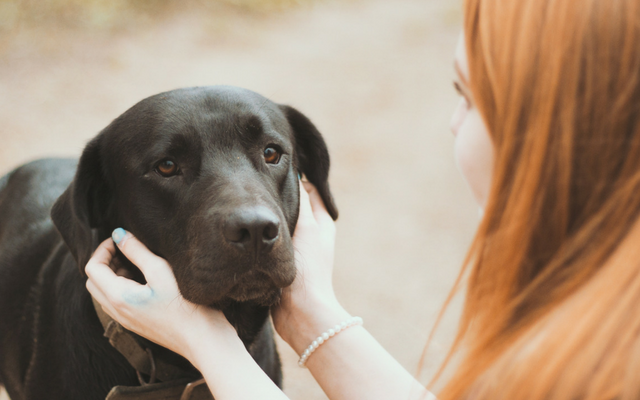Do dogs like it when you talk to them?
Of course they do!
Talking to your dog might seem one-sided, but you don’t need a verbal response to know chatting with your furry best friend is a good idea. No matter how silly you think having a talk with your dog sounds, striking up a conversation while you’re out on a walk, cuddling on the couch, or preparing dinner has benefits you probably don’t know about.
Yes, your neighbor might think you’re crazy, but if they have a dog of their own, they probably do it too! In fact, while not every dog owner will admit it, most people with good relationships with their pets find it natural to start chatting it up with their canines.
If this sounds like you, keep up the good work. And if you’re hesitant to start the conversation, don’t be shy, dogs like when we talk to them! Especially when its your pup, so here are a few reasons why talking to your dog on a daily basis is important.

5 Reasons to Talk to Your Dog
1. Talking to Your Dog Improves Your Bond
The bond between a person and their dog is a powerful thing. The potential for a relationship based on mutual love and respect is one of the main reasons why people adopt dogs in the first place. Anything that bolsters this bond is something dog parents should be interested in. Some dogs open their hearts after the first belly rub, but a real, enduring bond will take time and effort. Your dog needs to feel perfectly comfortable around you, and part of that is being used to hearing your voice.
Talking to your dog while you’re doing other things is a way to keep them engaged. There are plenty of active bonding moments during your day, like when you’re out exercising or teaching them a new trick, but talking can turn even the laid-back parts of the day into bonding opportunities. Listening to you tell them how pretty and smart they are initiates communication and gives your dog a reason to pay attention to you.
2. Human Speech Can Be Interesting
If you drone on about how awful your boss is, there’s a good chance your dog is barely paying attention. Your voice is probably a familiar-sounding buzz of background noise, and they’ll only start actively listening if they hear a word they recognize. Telling your dog about your day is good, but it’s even better to talk to them about things they can relate to and understand. They don’t speak the same language, but they’ve learned how to recognize dog-related speech, and studies show they enjoy listening to it.

Researchers at the University of York in the UK recently published a study about how dogs respond to human speech. They wanted to know if dogs can tell the difference between human and dog-related language and whether they benefit from one over the other. To find out, they performed experiments where people talked to dogs in different tones and about different subjects. They tested both “normal” tone of voice and the high-pitched kind of speech we humans can’t help but use when talking to babies and pets. They also switched up the content of the conversations between subjects unrelated to the dog and topics the dog could recognize. Those topics included phrases like, “Do you want to go on a walk?” and “You’re such a good dog.”
They measured the dogs’ responses to each combination of tone and content, and they found their canine conversationalists were most interested when speakers used dog-relevant words, and they remained actively engaged in listening when they thought the conversation was directly related to them. They learned that if you really want to engage your dog’s mind, regularly talking to them with words they understand is a good way to do it.

3. Talking to Your Dog Is Good For Human Health
Your dog will pay the most attention if you use words they understand, but chatting with your pooch isn’t only about them. Talking is a way for people to put their problems out in the open. Your dog doesn’t need to respond or offer their advice to help you work your way through a difficult situation. Simply talking about it out loud to a nonjudgmental audience is helpful. It helps you look at a situation objectively, and talking it through allows you to reflect on the facts and work your way toward a solution.
Talking to dogs is a technique many therapists and psychologists use when helping people cope with difficult situations and manage conflict resolution. Children often feel more comfortable directing their stories toward a dog than they do an adult, and people who have survived traumatic experiences find comfort in a dog’s listening skills. Canines are the best kind of soundboard, and talking to your dog about your daily problems is a good way to vent and maintain mental health.
4. Dogs Learn Through Repetition
You and your dog don’t speak the same native language, but dogs are expert linguists. They’ve learned to adapt to life with humans, and a big part of that is learning our language. They don’t understand things like sentence structure and grammar, but they can easily catch on to vocabulary.
A Border Collie named Chaser has proven she understands over one thousand words, and she can even respond appropriately to simple sentences. Chaser is a known brainiac, but even the average dog has the mental capacity to learn a long list of human words.
Some of the words your dog understands were explicitly taught to them, like “sit” and “stay.” There are also words they learned all on their own, like “ball,” “treat,” and “bath.” No matter which category the word falls under, the key to a dog’s understanding is repetition. They only learned “sit” because you said it over and over again during training. And they learned “treat” because it’s what you say before you hand over a delicious morsel.
Listening to you is the best way your dog knows how to learn, and every time you open your mouth, there’s opportunity for them to learn more. They’ll start picking up on words you say frequently, and that better understanding of your language will lead to improved communication between dog and person.

5. It’s Not All About Spoken Language When Talking To Your Dog
Words are only a small part of communication. When you talk to a friend, you string words into sentences, but you also use tone and body language to get your point across. Your face contorts into specific expressions that reflect your mood, you wave your hands for emphasis, and your tone of voice is more honest than the words you say.
Learning vocabulary is a lot of work for a dog, but they pick up on emotional cues a lot easier. They can tell what kind of mood you’re in by watching your face while you talk and listening to the slight changes of pitch in your voice. There’s a difference between human and canine body language, but they put all the pieces of the communication puzzle together to accurately figure out the basics of what you’re thinking. With time, they’ll learn to recognize the nuances between canine body language and human body language, and it’ll all lead to better understanding and communication.

Dogs Like It When You Talk to Them
The answer to our original question is a big yes; dogs do like it when you talk to them! So, the next time your neighbor catches you having an enthusiastic conversation with your dog, start spouting off these facts to kindly inform them of the benefits of talking to dogs. Whether you’re telling your pup about your dinner plans or going into detail about how wonderful they are, your conversation is an important part of your dog’s day. Making an effort to talk to them on a regular basis shows everyone, even that nosy neighbor, that you and your dog are the best of friends.
 Toledo, United States.
Toledo, United States.